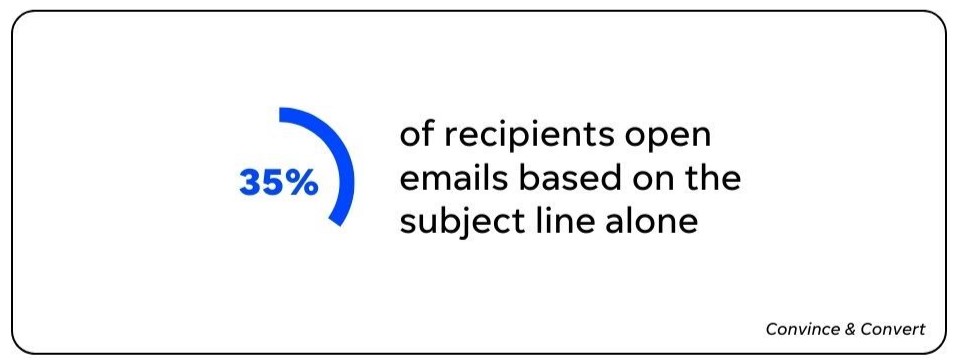You know what really stings? Pouring your heart into a perfectly crafted sales email only to get zero new sales from it.

What’s even worse is if you don’t know why the email didn’t work. You won’t be able to fix it and improve next time. That’ll leave you without all the benefits of this important marketing channel (e.g., email is an owned channel so you can connect with customers without the middleman of search engines or social media platforms).
Luckily, it’s easy to dissect your email campaigns to learn what works and what doesn’t. Email marketing key performance indicators (KPIs) are how you do it.
We’ve found the following 11 email marketing KPIs to be important measuring sticks for campaign success. We also added a handful of approaches to help you make the most of every email you send.
What are email marketing KPIs
Email marketing KPIs are metrics that let you measure how readers are engaging with your emails. They’re how you track progress against your goals and reveal insights that help you improve. Pay attention to the right KPIs and you’ll send emails customers can’t wait to open. And generate more sales for your business along the way.
11 essential email marketing KPIs to track
There are lots of ways to dissect your email campaigns. This group of KPIs is curated to give you a rounded view of customer behavior, technical operation, and bottom-line sales success.
1. List growth rate
Your list growth rate describes the net increase in the number of people subscribing to your email list. It takes into account both the number of people signing up and the number of people dropping off.
How do I calculate list growth rate?
The formula to calculate list growth rate is: [(new subscribers – unsubscribes) / total # of email recipients] x 100.

For example, if 80 new people sign up for your emails, 30 people say they don’t want them anymore, and you currently have a list of size of 1,300 people, your list growth rate is 2.3%.
Why is list growth rate important?
The more people you bring into your email funnel, the more chances you have to get more sales. Just be careful you’re not adding people just for the sake of growing the list. Some of the other KPIs will take a hit if you do.
2. Bounce rate
Bounce rate is the percentage of emails that get returned (“bounced” back) to you as “undeliverable.” These emails haven’t made it through to the target recipient for a couple of reasons.
A hard bounce happens because an email address is invalid or the domain doesn’t exist.
A soft bounce means that a mailbox was full or its server was down.
How do I calculate bounce rate?
The formula to calculate bounce rate is: (# of emails returned / # of emails sent) x 100.

So if you send emails to 1,000 people and 18 bounce back, your bounce rate is 1.8%.
Why is bounce rate important?
Bounce rate is an indicator of your email list’s health. A high bounce rate can actually damage your email domain’s reputation, relegating future emails to spam folders.
3. Deliverability rate
Deliverability rate tells you the percentage of emails that actually land in your subscribers’ inboxes. It differs from bounce rate because it includes emails that get stopped by spam filters or are directed to spam folders but aren’t bounced back.
How do I calculate deliverability rate?
The formula to calculate deliverability rate is: (# of successfully delivered emails / # of emails sent) x 100.

If you send out a batch of 1,500 emails and 1,350 find their way to a valid inbox, your email deliverability rate is 90%.
Why is deliverability rate important?
If your emails are getting trapped by spam filters, it means your content and domain are not trusted. Your hard work to grow your list won’t net the types of rewards it deserves.
4. Open rate
Email open rate is the percent of people that open your emails compared with the total number of emails that were successfully delivered.
How do I calculate open rate?
The formula to calculate open rate is: (# of emails opened / # of successfully delivered emails) x 100.

Say you send a weekly newsletter to 1,200 email addresses and 300 people open it, your open rate is 25% (pretty darn good considering the industry average is 21%).
Why is open rate an important email marketing KPI?
Open rate tells you a lot about how engaged your subscribers are. It also says if your subject lines are hitting the mark.
5. Click-through rate
Click-through rate tells you how many people clicked on a link in an email as a percent of the total number of emails successfully sent.
How do I calculate email click-through rate?
The formula to calculate click-through rate is: (# of recipients that clicked a link / # of successfully delivered emails) X 100.

For example, your sales email makes it through to 1,300 inboxes. You see that 30 people clicked a link that you placed in that email. Your click-through rate is 2.3%.
Why is email click-through rate important?
If you have a high click-through rate, it means your email is engaging, people trust you, and you’ve created a solid call-to-action (CTA). It also means customers are one big step closer to taking an action you want them to take, like setting an appointment or ordering a product.
6. Share rate
The number of people that share or forward your email with others is the email share rate.
How do I calculate share rate?
The formula to calculate share rate is: (# of emails shared / # of emails successfully delivered) x 100.

Let’s say 50 of the 1,800 people you sent an email to forwarded it to someone else. Your share rate is 2.8% (rounded up from 2.777…).
Why is share rate an important email marketing KPI?
Sharing is caring, and when people forward your email you know they care about what you’ve sent. Share rate is a barometer for how relevant your emails are and how much trust your subscribers have in you.
7. Conversion rate
When someone takes an action you’ve requested—like making a purchase or calling for more info—that’s a conversion. So email conversion rate is the percent of people that take the action you want them to after receiving an email.
How do I calculate conversion rate?
The formula to calculate conversion rate is: (# of recipients that take a desired action / # of successfully delivered emails) x 100.

If you get 85 new appointments from the 1,500 emails you sent, your conversion rate is 5.6%.
Why is conversion rate important for email marketing?
Conversions are the most important outcome for most email marketing campaigns. So if your conversion rate is high, your emails are doing the job. Now you just need to increase your subscriber list and open rate to get even more people taking action.
8. Revenue per email
Revenue per email tells you how much money, on average, you make from each email you send.
How do I calculate revenue per email?
The formula to calculate revenue per email is: (revenue from emails / # of successfully delivered emails).

Say last month you earned $14,000 from people who bought after receiving your newsletter. In total, your newsletter landed in 400 inboxes. Your revenue per email is $35.
Why is revenue per email important?
Revenue per email is a way to standardize a comparison between different campaigns or A/B tests. For example, you might send one email campaign to 500 people and another to 1,000 people. The second one brings in more total dollars. But the first one had a higher revenue per email. You’d then know that the emails in the first campaign were more effective at generating sales for some reason.
9. Email return on investment
Email return on investment (ROI) is a measurement of how much net revenue you’ve generated from an email campaign as a percentage of the cost to earn it.
How do I calculate email ROI?
The formula to calculate ROI is: [(campaign revenue – campaign cost) / campaign cost)] x 100.

For example, customers clicking through your emails bought $5,000 worth of product. You paid a total of $500 for an email marketing platform and someone to run it. Your ROI on that campaign is 900%.
On average, email marketing generates $36 for every $1 spent. Although results may vary depending on your business type and what you’re promoting through your email marketing campaigns.
Why is ROI an important email marketing KPI?
You’ll often need to compare the effectiveness of different marketing channels. Do you get more benefits from email or PPC campaigns? ROI is a simple way to make those apples-to-apples comparisons.
10. Unsubscribe rate
The proportion of people that unsubscribe from your send list after opening a specific email.
How do I calculate unsubscribe rate?
The formula to calculate unsubscribe rate is: (# of people that unsubscribe / # of successfully delivered emails) x 100.

If 2,000 people received your email and 50 of them unsubscribed, your unsubscribe rate is 2.5%.
Why is unsubscribe rate important?
Sometimes people no longer need the information or promotions you offer. For example, parents of older children may unsubscribe from your weekly deals on baby clothes. But a high unsubscribe rate suggests something about your email campaigns is off-putting. It could be the content or the frequency. Your unsubscribe rate tells you if changes are needed.
11. Spam complaint rate
Unfortunately, some portion of your email recipients may decide to mark an email as spam. The percentage of recipients that do is known as the spam complaint rate.
How do I calculate spam complaint rate?
The formula to calculate spam complaint rate is: (# of people that mark an email spam / # of successfully delivered emails) x 100.

You send an email to 1,500 people. Then 300 of them mark it as spam. Your spam complaint rate is 20%.
Why is spam complaint rate important?
Like a low deliverability rate, a high spam rate damages your email domain’s reputation. It’ll be less likely that future emails reach people. If lots of people mark one of your emails as spam, look closely at the content since it may come off as aggressive or too salesy.
How to improve your email marketing KPIs
Here are six strategies to keep those conversions coming in and kick unsubscribes to the curb.
Confirm email addresses
Sometimes people mistakenly type in an incorrect email address. Other times they give a fake one to take advantage of a promotion. Either way, those faulty addresses can add up to poor delivery rates and a ding on your email domain’s reputation.
The cure is to include a double opt-in procedure for new subscribers. Usually, that means they enter their address and then click on a confirming email sent to their inbox.
Share great content
OK, this one is kind of a no-brainer. But try to put yourself in your customers’ shoes. If you didn’t love your company, would you still be happy to get your emails? Think about the value of the deals you offer and how helpful your content is.
Oh, and don’t forget the design.

A clean, pleasing layout with professional-quality images lends a lot of clout to your company. Just make sure it looks as good on mobile as it does on desktop.
Related: These 75 newsletter ideas will give you enough content for a year’s worth of emails.
Segment your audience
Do you have several different types of people that buy from you? Like maybe some are DIYers that want instructions while others prefer a white-glove service?
If so, try segmenting subscribers into subgroups. You’ll end up sending more relevant emails to everyone that keeps them smashing that open button.
You can group subscribers in all sorts of ways like location, interests, or where they are in your sales funnel. Practice a few and see what works best.
Write irresistible subject lines
Your subject line is your email’s marquee. It’s the neon sign that jumps out in a crowded inbox to grab the interest of busy customers. Make your subject lines interesting, informative, and always honest (misleading subject lines will send your content right to spam jail).

Need a little help? Here are 74 revenue-boosting subject lines you can start using right now.
Create better CTAs
If email marketing is a marathon, your calls-to-actions (CTAs) are the last step of the final mile. Get them right, and you’ll see a steady stream of customers rushing to your website.

And make sure you keep the promises in your CTA. If you say “join now for weekly deals” but only deliver a discount once a month, you’ll frustrate many of your followers.
Here are 50 powerful calls to action to get you started.
Scrub your subscriber list
Periodically go through and declutter your email list. Remove inactive, unengaged, and invalid addresses. Do this a few times a year, before starting a new campaign, or when you notice bounce rates creeping up.

You should also include an unsubscribe link in each email. That’ll let people who aren’t interested in your content remove themselves.
A clean contact list reduces bounces, giving your email reputation a boost. It will also lead to higher conversion rates and better overall ROI for your email marketing efforts.
Get more sales using email marketing KPIs today
KPIs are like health vitals for your email marketing campaigns. They expose trends so you can address sliding performance quickly or capitalize on early gains. That way, a bump in bounce rate doesn’t spiral into a big loss of conversions.
And speaking of trends, here are 8 email marketing trends you should follow. From interactive elements to AI, these topics and tidbits will help you create emails people can’t wait to open.
Here are the 11 email marketing KPIs you should be tracking:
- List growth rate
- Bounce rate
- Delivery rate
- Open rate
- Click-through rate
- Share rate
- Conversion rate
- Revenue per email
- Return on investment
- Unsubscribe rate
- Spam complaint rate






